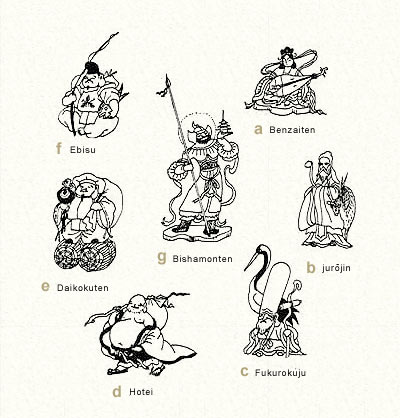| Lit.
the seven gods of good fortune. The group comprises *Ebisu 恵比須, *Daikokuten 大黒天, *Bishamonten 毘沙門天, *Benzaiten 弁財天, *Fukurokuju 福禄寿, *Juroujin 寿老人
and *Hotei 布袋. In paintings,
the seven are frequently shown riding in a treasure boat *takarabune 宝船, which is an auspicious symbol, especially found during New Year celebrations.
The seven deities have independent origins in Buddhism, Taoism and Shinto.
Although the impetus for the grouping is uncertain, these seven auspicious
deities are first believed to have been grouped together and given the name shichifukujin during the Muromachi period. At first, the members of the
group were not fixed and Benzaiten became one of the seven deities
somewhat later. The group of seven may derive from the Chinese subject of
Seven Sages in a Bamboo Grove *chikurin
shichiken 竹林七賢 of the Wei-jin dynasties or
from the famous Buddhist term from the sutra NINNOUGYOU 仁王経, shichinan
sokumetsu shichinan sokushou 七難即滅 七難即生 (seven adversities
disappeared and seven fortunes arose). From the 15c. the shichifukujin gained in popularity, especially among urban merchants and artisans, as
an auspicious omen and motif of good fortune and longevity, and appear in
many painted, sculpted or printed examples. Typically Ebisu wears
courtly hunting clothes with a folded, pointed cap kazeori eboshi 風折烏帽子, holds a fishing rod in his right hand and a freshly caught red snapper tai 鯛 in his left. Daikokuten usually wears an ancient courtly
hunting dress and a cloth cap, stands on two bushels of rice, carries a
huge bag over his left shoulder, and holds a mallet of good fortune kozuchi 小槌 to his chest. Bishamonten often sports a thin mustache and beard,
wears the ancient Chinese style dress of guardian deities, holds a spear hoko 矛 in his right hand and a Buddhist pagoda *tahoutou 多宝塔 on his left palm. Benzaiten is usually represented as a beautiful
goddess in courtly garb, playing a lute biwa 琵琶. Fukurokuju is recognizable by his high-domed bald head and beard. He wears a Chinese
robe, and holds a staff. Often accompanied by a crane. Juroujin,
in the dress of a Chinese sage, holds a staff and a scroll, often accompanied
by a deer. Hotei is a stout, pot-bellied figure who either leans on a huge,
bag or carries it hung on the end of his staff which is slung over his shoulder. |

